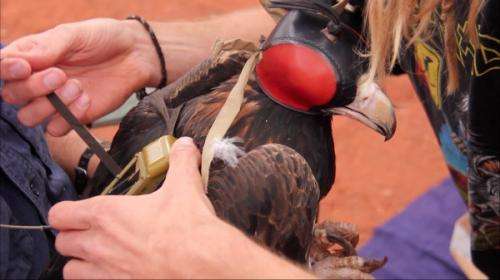Eagle research soars via GPS trackers

A world first study tracking wedge-tailed eagles (Aquila audax) via GPS satellite transmitters has led one researcher into uncharted territory after a female appeared to have her partner stolen by a new bird, challenging a long-held belief that this species mates for life.
Perth Hills-based ornithologist Simon Cherriman used the solar GPS technology—Platform Terminal Transmitters (PTTs)—to track the birds to map out new inroads into raptor research.
Each PTT was programmed to record a GPS fix at almost every hour of daylight and was fitted to two adult and two juvenile eagles at the Lorna Glen proposed conservation reserve in the Murchison.
Mr Cherriman says the project is very exciting because never before has anyone been able to look at a map and view the location of Australia's largest predatory bird remotely.
He has researched eagles at Lorna Glen since 2011 but the trackers on two adults last year gave greater insight into their movements and habitat over a 12-month period.
Mr Cherriman says a lot of the data gathered confirmed adults did not move far from their fixed home range but the size of these ranges (25-50km2) was a lot smaller than that determined by earlier research conducted in arid zones during the 1970s.
He says the work has revealed the eagles are intelligent strategic hunters who regularly visit a few key spots in their range.
The technology has helped measure how high the eagles can fly with one male found to have soared to 6000m.

Mr Cherriman was also surprised to find a female was possibly ousted from her territory by a younger bird.
"It appears to be the case but we would need to track more pairs to confirm this," he says.
The trackers have also confirmed the sedentary nature of breeding adults who tend to remain on their home ground.
Mr Cherriman says a young female has flown 15,000km since March.
"Earlier studies have shown juveniles can travel huge distances in their first year before they eventually settle into a home range but the finer details of their travels haven't been looked into."
Mr Cherriman will now track two baby eagles and their travels during their first year of flight.
To make his eagle research accessible to a wider audience Mr Cherriman has created a blog, and a documentary about his research Where do eagles dare, which screened at Curtin University this month.
Provided by Science Network WA















